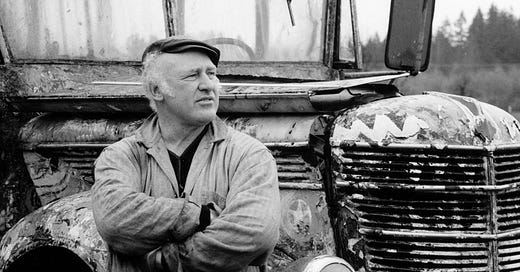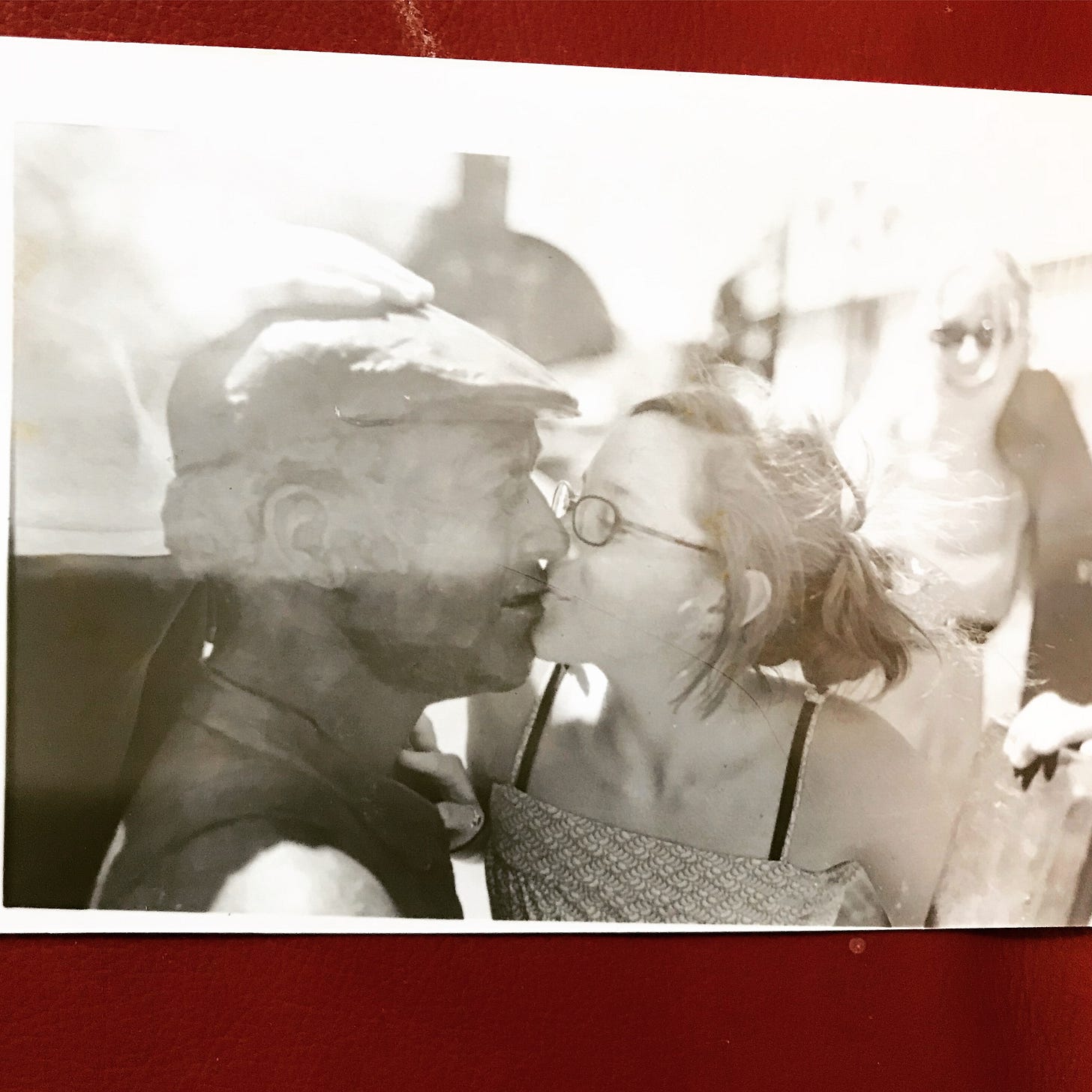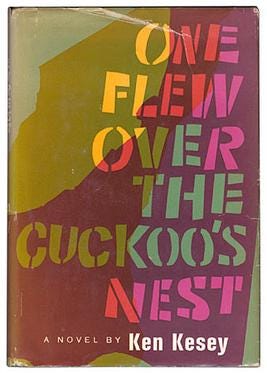What Kesey saw that inspired 'Cuckoo's Nest'
“Society is what decides who's sane and who isn't, so you got to measure up.”
In the fall of 2001, my high school English teacher modeled grief in front of our classroom. A native New Yorker often prone to wearing a Jeter jersey on Yankee game days, September 11 was personal — a stark contrast to us, these Oregon teens, most of whom had never even seen the Atlantic — and she stood before us, vulnerable and honest and gutted.
And then something else happened, maybe something worse. Ken Kesey died. And that’s when we saw the real anguish of loss in our teacher’s face.
Kesey was a legend where I grew up. I mean, he was kind of a legend everywhere, to a certain kind of literary person, but especially in the Eugene/Springfield area, where he was our legend. At 66 — which felt old then but feels less old to me now — he had been battling liver cancer and host of other ailments, mostly the result of a life lived thoroughly and with the assistance of any number of substances.
For my teacher, an intimate, personal friend of his, the grief seemed unbearable. And to her infinite credit, she channeled the anguish into something powerful. She changed the curriculum of our class — and laid out a reading curriculum for the city — so that we could appreciate his life and legacy.
I was 14 years old that winter when I first read Sometimes A Great Notion and it’s still my favorite book, maybe ever. In part because it was introduced to me at a time that felt consequential, but also in part because it’s brilliant and it feels like home.
Of course, I’ve read One Flew Over the Cuckoo’s Nest, too. Up there with The Bell Jar, it’s about the most famous book ever to be set, either partially or entirely, in a mental institution. I liked it, too, though not as much as Notion (and I’m really not that into the movie, sorry nerds). But I think more interesting that the book itself is how the book came to be, how Kesey came to the idea. I suspect most people who have just seen the film might assume he was a patient, that he was institutionalized.
But the way he came to write the book is, I think, a lot more interesting.
“I got a job at the nut house…and made a lot of good friends”
In 1960, Ken Kesey was a creative writing student at Stanford. Like a lot of us, he took basically any job he could that would allow him to write a little, learn a little, and earn a little. He was 25 when he found himself the subject of paid drug experiments at the Menlo Park Veteran's Hospital. After the stint was over, he applied for a job as an orderly, which provided him with insight, material, and an unregulated supply of drugs.
Talking to Terri Gross in 1989 (!), Kesey described the experience:
I got a job at the nut house, and worked from midnight to 8 writing that book and taking care of these patients on this one ward and made a lot of good friends - some that I still have. And I found that my key opened a lot of the doors to the doctors' offices, where these drugs were being kept.
Incredible. What a time!
I often think of a writer as a kind of mechanical process — what comes out is a direct function of what goes in. The final product is a result of the input material and its reactions to the various Rube Goldberg-esque devices that fire inside your brain. Boring writers have very little process from input to output. Really excellent writers consume input material, turn it around and combine it and stretch it, producing something that is wholly new.
Kesey did that. And as a result, he created a novel that examines the closely-held social mores of the 1950s, that investigates assimilation and conformity, and that, yes, provides a picture of the way we think about sanity.
Again from his Fresh Air interview:
At that time, you know, everything was Freudian. If you were messed up, it was because of something that had happened to you when you were in the bathroom as a kid. And with these experiences — and I don't just mean drug experiences — there were a lot of other things that were going on that were emphasizing this.
John Coltrane's music was saying the same thing. It was saying, something is wrong and it's making us a little crazy and that is making us crazy enough to hallucinate, whether we were promoting it ourselves or it was being imposed on us - I don’t want to argue that now. But when I would - I felt so good after being on there all night, to know that I was wearing…a white uniform instead of a green uniform, so I could leave in the morning and go home. Otherwise, there wasn’t that much difference between me and those people they were locking up.
This is, I think, the aspect of Cuckoo’s Nest that is the most critical for so many readers. It was one of the first pop-culture-facing novels to really explore both the treatment and the perception of institutionalized people. At a time when housing them away in large Kirkbride buildings was de rigueur (and funding for those was being slowly whittled away), few “normal” people really considered the day-in of people living with (or convicted of) mental disorders.
Kesey, having walked those halls as both a pseudo-patient and an employee, gave readers a view through the plate-glass windows, revealing the relationships, the conditions, and even the treatments.
Brain Burning
One treatment which fascinated Kesey — probably because he was down to try literally anything mind-altering — was electro-convulsive therapy, or shock treatments. He even volunteered to try it once, just to see what it was about. Years later, when the production was brought to the stage and absolutely destroyed by critics who claimed it was “unrealistic,” Kesey responded that “I wished to try shock treatment to get some idea why the patients thought it so bad. And I did. And I found out. And to those who think it is fictionally exaggerated I only say try it first and see.”
In the book, Kesey introduces the controversial (but still practiced, and for some people, very effective) treatment:
“That’s the Shock Shop I was telling you about some time back, my friend, the EST, Electro-Shock Therapy. Those fortunate souls in there are being given a free trip to the moon. No, on second thought, it isn’t completely free. You pay for the service with brain cells instead of money, and everyone has simply billions of brain cells on deposit. You won’t miss a few.”
He frowns at the one lone man left on the bench. “Not a very large clientele today, it seems, nothing like the crowds of yesteryear. But then, c’est la vie, fads come and go. And I’m afraid we are witnessing the sunset of EST. Our dear head nurse is one of the few with the heart to stand up for a grand old Faulknerian tradition in the treatment of the rejects of sanity: Brain Burning.”
A lot of neurotypical people, evidently, thought the descriptions of ECT were made out to be more, uh, electric than they were because a.) they hadn’t read the Bell Jar or b.) they just weren’t aware of what happened in mental institutions. Right up there with lobotomies and boring holes in the head (we’re going to talk about that in a future issue), ECT was one of the more extremely treatments that a patient might experience, whether they needed it or not.
This kind of exposure to the realities of an institutional setting was novel to a lot of readers in the 1960s — to the point that many people viewed the portrayal as outsized. But, Kesey explained, that was a convenient was to shy away from the facts that he, himself, had witnessed.
“…The notion that this setting is only a fictional and fantastic one does an injustice to thousands of patients in hundreds of wards almost identical to that ward on the stage of the Cort. While Cuckoo's Nest is…about more than just a mental hospital, it is also an attack on tyranny of the sort that is perhaps more predominant in mental hospitals then any place else in our land. It is by no accident that the acute ward was picked for the setting; after working for close to a year as an aide in two hospitals in California I could imagine no better backdrop for my parable. I only needed describe what I had seen and heard, what I had felt after endless swing shift hours talking with the broken and defeated men of our society, and what I concluded to be the stress that broke them.”
It’s Hard on the Eyes
Of course, Cuckoo’s Nest, as a book, certainly has some modern-day issues. This is by no means an attempt to dodge the stranglehold of bombastic white male writers over literature. Much of it does not, as the kids say, hold up.
But as I’ve been thinking about this book (now more than 60 years old!!!) and its portrayal of one institution through fiction, I’ve been reminded of the necessary role of literature, both fiction and non, in our understanding of mental health. From Beloved to White Oleander to The Virgin Suicides to The Unquiet Mind, there’s now a rich, robust body of work about mental illness, institutions, and the treatments that people endure in order to be “normal” or at least “better.”
But in 1962? Not so much. And while Kesey was, like all of us, an imperfect human person, he was kind of an excellent messenger for this information. He drifted between an insider and an outsider, he was young and compassionate and curious. And he wrote about the experiences of others, painting them into the larger tapestry of the work, rather than assuming or writing about how he thought these spaces might be. Plenty of lazier writers have thought to set their works of fiction in “a nuthouse.” Few actually got ECT to see what it felt like.
In closing, I’ll leave you with this final quote from his Fresh Air interview:
Make no mistake about it - being crazy is painful. And being crazy is hell, whether you get it from taking a drug or whether it happens because youre just trying to lead the American way of life and it keeps kicking your legs out from under you. One way or another, it's hell on you. And it's nothing that's fun about it, and I am certainly not recommending it. It is a lens through which I looked at stuff, but its hard on the eyes. But I think I had a very valid viewpoint, and much closer than a lot of the doctors were having.






